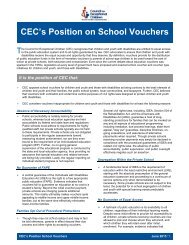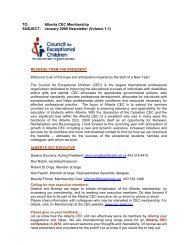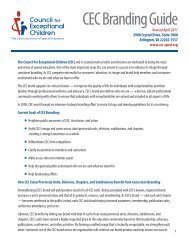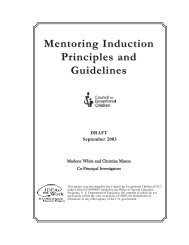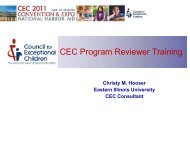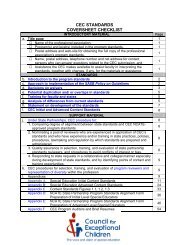What Every Must Know Special Educator - Council for Exceptional ...
What Every Must Know Special Educator - Council for Exceptional ...
What Every Must Know Special Educator - Council for Exceptional ...
You also want an ePaper? Increase the reach of your titles
YUMPU automatically turns print PDFs into web optimized ePapers that Google loves.
standards (<strong>for</strong> moderate/severe) should be included.<br />
The CEC Standards Flowchart (Appendix 3) can be of<br />
assistance in determining the appropriate knowledge<br />
and skill sets.<br />
Address the Entire Content Standard<br />
Most of the CEC standards are complex with multiple<br />
components. All of these components <strong>for</strong> each of the<br />
Standards should be included in the assessment plan.<br />
For example, CEC Standard 8: Assessment requires the<br />
teacher candidate to understand assessment (legalities,<br />
theory, and practice), conduct both <strong>for</strong>mal and in<strong>for</strong>mal<br />
assessments, and monitor progress of students as<br />
part of the standard. Thus, the assessment system developed<br />
by your program needs to document mastery<br />
of the multiple components within the CEC Standard.<br />
CEC made this relatively easy <strong>for</strong> you by bolding key<br />
words in the descriptions of the standards.<br />
Align Assessments with CEC Content Standards<br />
Providing an alignment matrix <strong>for</strong> the components<br />
of the assessment and the CEC standards will allow<br />
the reviewer to assess the relationship between the<br />
assessment and the standards more easily. This alignment<br />
can then be transferred to the scoring guide <strong>for</strong><br />
documentation of mastery of the standards.<br />
Develop scoring guides <strong>for</strong> each assessment<br />
Scoring guides must be sufficiently complete to allow<br />
the reviewer to understand what standards are being<br />
met by what component of an assessment. Aligning<br />
the CEC standards to your scoring guide again provides<br />
the reader with a quick analysis of the standards,<br />
criteria <strong>for</strong> mastery, and candidate per<strong>for</strong>mance. Many<br />
programs use rubrics <strong>for</strong> the majority of their scoring<br />
guides to facilitate consistency across grading and<br />
expectations of candidate per<strong>for</strong>mance.<br />
Develop a Common Rubric Format<br />
If the faculty chooses to use rubrics, the rubric <strong>for</strong>mats<br />
should be consistent across assessments with the rating<br />
scale, the <strong>for</strong>mat, and wording. Choose a rating<br />
scale and descriptors that all graders/raters are willing<br />
to use. Do you want a three-, four-, or five-point<br />
scale? <strong>What</strong> are rating descriptors, e.g., unacceptable,<br />
acceptable, target or not met, met, exceeds? The key is<br />
to use a consistent <strong>for</strong>mat, including the direction of<br />
your number scale (left to right or right to left), <strong>for</strong> all<br />
rubrics to ease comparison and program review.<br />
284 whAt every SpeCiAl eduCAtor muSt <strong>Know</strong><br />
Strategies <strong>for</strong> the Program Review<br />
Report<br />
Be consistent in your presentation of the assessments,<br />
scoring guides, and data. For each assessment, the report<br />
should provide the description of the assessment,<br />
alignment of CEC standards with the assessment, and<br />
findings/analysis of the data. Attachments <strong>for</strong> each<br />
assessment will be the directions to the candidate<br />
(actual assignment), scoring guide/rubric, and data.<br />
Following the same <strong>for</strong>mat and sequence <strong>for</strong> each<br />
assessment will allow <strong>for</strong> an accurate and efficient<br />
review.<br />
Presenting Data<br />
The report must provide data to document that program<br />
candidates are meeting the standards, and/or<br />
that changes have been made to the program based<br />
upon per<strong>for</strong>mance data from the candidates. It is<br />
important to provide the data in aggregated <strong>for</strong>mat,<br />
<strong>for</strong> each semester or year that the class is taught, <strong>for</strong><br />
different locations if applicable and <strong>for</strong> different program<br />
groups if possible. The “N” should be provided<br />
(number of candidates included), with the number and<br />
percentage of candidates per rubric title, or categories<br />
(unacceptable, acceptable, target). You could also<br />
report this as the number of candidates who earned<br />
the rating. The assessment items should be clearly<br />
documented, along with the semester and year the<br />
data was collected.<br />
Findings<br />
As the faculty collects the data, they should analyze the<br />
data to identify areas <strong>for</strong> improvement in the program.<br />
The faculty also documents when no improvements<br />
are identified based on the data. This continuous<br />
improvement analysis must be described in Section V<br />
(Use of Assessment Results to Improve the Program)<br />
of the program report.<br />
Connecting CEC Program Review and<br />
NCATE Unit Review<br />
NCATE unit Standards and Accreditation<br />
NCATE accreditation is based on the unit conceptual<br />
framework and six standards. The unit’s conceptual<br />
framework describes the shared vision that guides ef<strong>for</strong>ts<br />
to prepare candidates to work in P-12 schools. It<br />
is the compass <strong>for</strong> making unit level decisions and the




